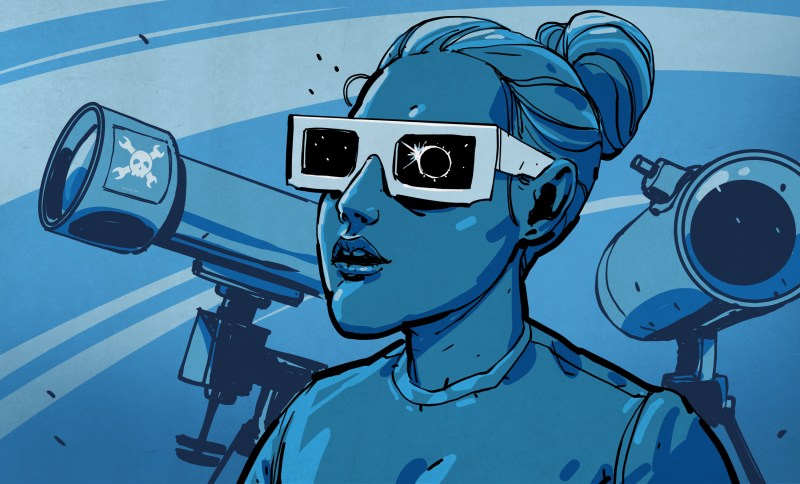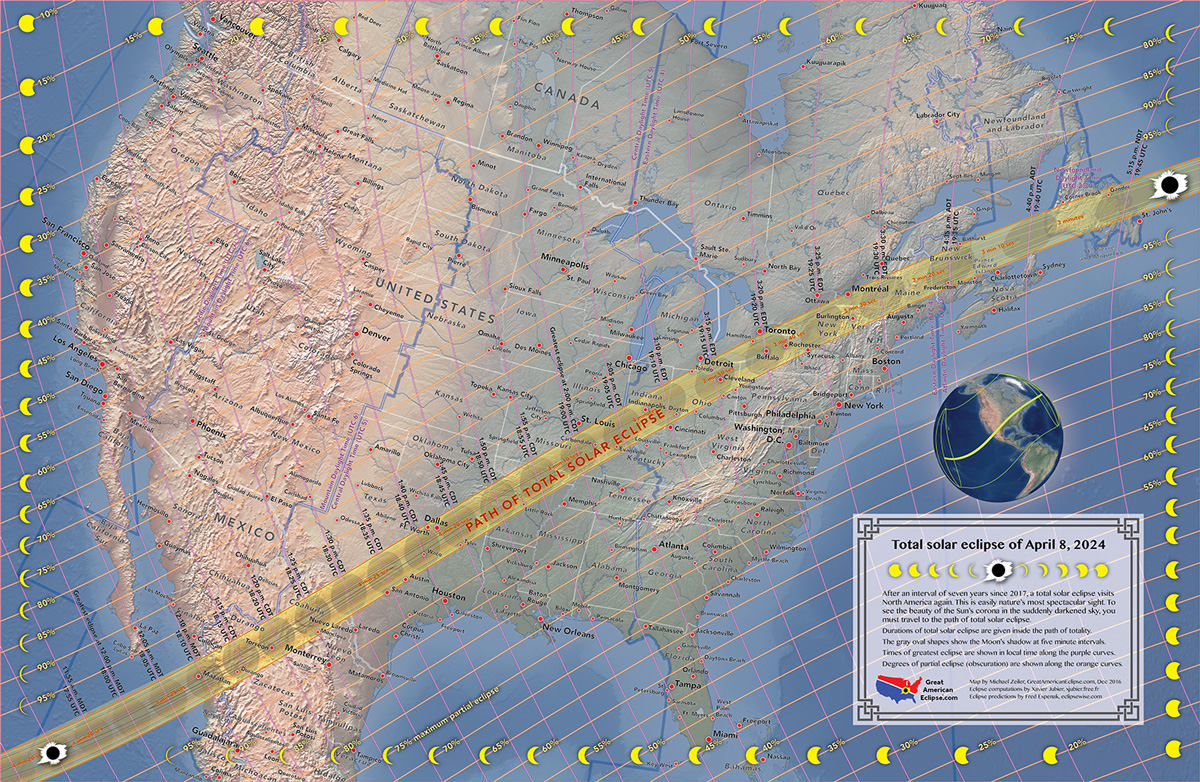
It seems like only yesterday that the “Great American Eclipse” swept from coast to coast, and for those who were lucky enough to watch it from along the path of totality, it was a true life experience. No natural phenomenon can compete with the beauty of a total solar eclipse, and if there’s one thing I heard more than anything else in those golden moments after the Sun returned from behind the Moon, it was, “When’s the next one?” Everyone wanted to do it again, and for good reason.
Back in 2017, that question was kind of rhetorical; everyone knew the next eclipse to cross the United States was a mere seven years off. For me personally, the passage of time has not dampened my enthusiasm for eclipses one bit, and I suspect the feeling is mutual among the many people who gazed in wonder and childlike glee at the celestial proceedings of 2017. But except for the very lucky who live within the path of totality, mounting an expedition that optimizes the viewing experience takes preparation. Now that we’re a little less than a year away for the next one, it’s time to get geared up and make plans for the 2024 eclipse.
Where and When?
The 2017 eclipse’s “Great American Eclipse” moniker was well earned, as the continental United States was the sole beneficiary of the view. This time around, the US isn’t the only country along the path; Mexico and Canada will also get in on the fun. In fact, Mexico may well be the best place to watch the eclipse from, but more on that later.
The date you’ll want to mark in your calendars is April 8, 2024. As for the time, you’ll need to be careful; the eclipse will cover five time zones on its way across North America, so you might want to use a time zone converter or other resources to make sure you don’t show up an hour late. We can say that according to NASA’s all-inclusive eclipse page, the Moon’s shadow will first touch the mainland just south of Mazatlán on the western coast of Mexico at 11:07 AM PDT. From that point, the show is on.

The eclipse will enter the United States north of Eagle Pass in Texas, and proceed in a generally northeast direction from there. The first big city to be brushed by the 125-mile-wide umbra of the Moon’s shadow will be San Antonio, but just barely — totality will only last a few minutes in the city proper. If you’re a totality junkie — and you really should be — a 40 minutes drive to the northwest will get you a much better show.
As with many things, Texas gets the lion’s share of this eclipse, with a glancing blow on Austin and near-direct hits on Waco, Killeen, and Dallas before heading off into Arkansas. St. Louis and Memphis are near misses, but Indianapolis is nearly in the centerline of totality. The shadow almost completely covers Lakes Eire and Ontario, putting Cleveland, Buffalo, and Rochester in a good position to see totality. Burlington and Montpelier, Vermont are the last major US cities to experience totality, with Montreal getting brushed by the northern fringe of the shadow. The show is finally over for the US as the shadow rakes across northern Maine, well above the population centers on the coast, and eventually winds its way out into the North Atlantic by way of New Brunswick and Newfoundland at 5:16 PM NDT.
Totality? Totally!
Just like the 2017 eclipse, the path of totality for this one passes through the most densely populated parts of the US and Canada. Literally everyone in the country will be able to see at least some of the eclipse; even Seattle, the major city that’s farthest from the eclipse’s path, will see about 20% totality. But millions of people will be within reasonable driving distance of the path of totality, which begs the question: Is it worth it?
Speaking from experience, absolutely! For the 2017 eclipse, I took my family on a trip to eastern Idaho near the city of Rexburg, a drive of about ten hours from our home in North Idaho. Driving that far in search of a couple of minutes of darkness in the middle of the day might sound crazy, but unless you’ve been within totality, you don’t know what you’re missing. The entire experience was magical. Granted, that might have had something to do with the setting — we were perched on the rim of an extinct volcano — and the fantastic social aspect of the whole thing. But if you have a chance to get into the path of totality, take my advice and make the effort. You won’t be disappointed.
As for choosing a specific location, things are going to be a lot different this time around. The 2017 eclipse was in August, a month when summer weather patterns are fully in control across most of the United States. Clouds were few and far between for our chosen viewing location, and we got a great show, as did millions who made the trip to totality that day. But the 2024 eclipse is in April, a time when winter and spring are still fighting things out, meteorologically speaking. Interesting Engineering did an article recently on what your prospects are for clear weather along the path of totality, and — well, let’s just say it’s not as good this time around.
If you’re in Mexico, you’re probably good — most locations along the path have a 75% chance of clear skies. Further along the path, historical cloud cover ranges from 60 to 65% of the sky from Texas to Arkansas for April 8, and it only gets worse the further north and east that you get. Anyone who has experienced the endless winters of upstate New York and northern New England knows that even though there may be warm days in early April, they’re few and far between, and rarely does the Sun show its face at that time of the year.
Another factor to consider is that while the 2024 eclipse will only graze the official boundary of “Tornado Alley,” it still plunges right through an area that is prone to these storms. Plus, April is a time when it’s easy for cold, dry air descending off the east face of the Rockies to meet up with warm, humid air coming up from the Gulf of Mexico, and when those two air masses collide — well, let’s just say that if you get cheated out of seeing the eclipse, you may well get another kind of natural spectacle.
Taking all this into account, my advice for totality seekers is to stay mobile. You only need a two- to four-minute gap in the clouds to see the whole thing, and that could easily be within a short drive. Our strategy for the last eclipse was risky — committing to a viewing location that took an hour to hike to made it impossible to scramble up the road a few miles if a sudden storm came up. Granted, the view we got was totally worth the risk, but the whole thing could have easily been ruined, and knowing that it could have been fixed at the cost of a few gallons of gas would really have stung.
So this time around, we’re going to stay flexible. We’re driving all the way from North Idaho to near Austin, Texas, in part to see the eclipse from as close to centerline as possible, but also to visit with some dear friends I haven’t seen in far too long. I’m planning to do some military-grade pre-planning, using this interactive tool to generate maps of every possible route within the path of totality, and perhaps even pulling down real-time satellite data in case we need to bug out and find another location. I’ll also probably be on the air with the local hams, checking conditions and making sure I can make informed decisions if a last-minute change is needed.
Prepare to Pay

One thing that totality chasers will have to keep in mind is that this isn’t going to be cheap. Every hotel and motel owner, not to mention everyone with an AirBnB or VRBO, knows this eclipse is coming, and they’ll be pricing their services accordingly. And sometimes eye-wateringly so — a news story out of Eire, Pennsylvania, which will see over four minutes of totality, tells of hotel rooms that normally cost $100 a night going for five to nine times that amount on the date of the eclipse. That seems to be an artifact of online booking, though, since a direct call to one of the overpriced hotels resulted in a booking for only $200 a night, which really isn’t that egregious. Still, you’ll want to be careful with bookings, unless you can depend on the kindness of friends; here’s hoping one of my Texas friends has a spare room. Ben? Jessica?
No matter where you stay, you’re going to have to be prepared for observation. As we outlined last time, direct viewing of the Sun anywhere outside of totality requires eye protection, with eclipse glasses being the best bet. A shade 14 welding helmet filter will do the trick too, as will pinhole cameras and the like for indirect viewing. Don’t use smoked glass — you don’t want to trust your eyesight to a random layer of candle soot on a glass slide. On Menan Butte in 2017, the Hackaday-branded eclipse glasses were a big hit; we’ll see if we can bring those back this time around.
Astronomically speaking, total solar eclipses aren’t all that rare. But given the size of our planet and the fact that its surface is 70% water, having an eclipse come close enough to you that it’s feasible to go see it feels like it’s a “once-in-a-lifetime” event. Getting a second chance to see one, especially when you’ve been bitten by the totality bug, feels like a rare opportunity indeed. Make your plans, get prepared, and if you end up anywhere near the Austin area on April 8, drop me a line and maybe we can arrange a meet-up — Hackaday eclipses are the best eclipses!
Getting Ready for Act 2 of the Great American Eclipse
Source: Manila Flash Report
0 Comments